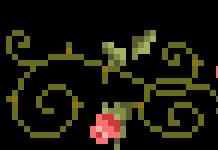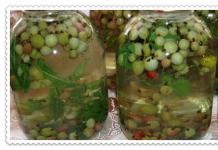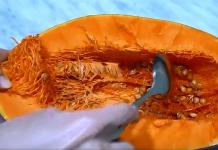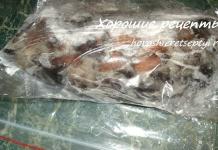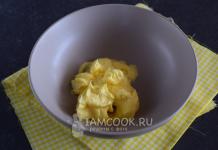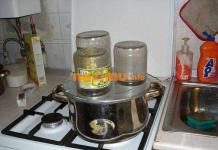
Why can't I grow the same bunches of grapes as the ones shown by the traders in the market? What is their secret?
The fact is that seasoned winegrowers who grow grape seedlings for sale, for the purpose of advertising, show specially grown so-called. marketing bunches. They choose a young, powerful bush at the age of 5-7 years of medium-late ripening (2nd half - end of September) of such a variety, which, according to ordinary criteria, gives medium-dense clusters weighing 600-900 g with berries weighing 8-10 g. The bush should have enough sunny light even in an unfavorable year for the full ripening of the bunches. It should not be shaded by trees or other shrubs and should not grow in an open, sunny location. The bush must be free of pests and diseases.
Shelter vines for the winter
In the autumn, before frosts, regardless of whether it is an ordinary variety or complex resistant, the vines are removed from the arch, preparatory pruning is done, tied into fascina and treated with a substance of steel vitriol (400 g per 10 liters of water) so that the kidneys do not get pummeled under cover. The bush is dried and firmly covered with insulating material in winter.
Around the bush, 50-60 cm from the trunk, a groove is dug 35-40 cm deep (the zone where the main mass of roots is located) and several buckets of rotted cattle or horse manure are brought into it. Poultry manure and pig manure do not need to be brought in. Until the ground is frozen, the roots will grow and feed. By the beginning of the spring growing season, the smallest organisms living around the roots will perfectly prepare the manure for its assimilation.
Operations that need to be carried out with a bush of grapes in spring
- In the spring, with the establishment of stable heat, the bush is opened, cleaned of peeled bark, under which pests hibernate, pruned, leaving a small number of eyes (60-70% of the norm)
- We treat the bush with DNOC (100 g per 10 l of water), which firmly kills wintering spores of fungal diseases, ticks and their testicles, pupae of leaf rollers and other pests.
- When shoots begin to grow from the eyes, doubles, tees are immediately removed, and the bush is given a watery top dressing of aqua with mullein (1: 6) or chicken droppings (1:10) - 1-2 buckets per bush. If there is no mullein, use urea - 30-40 g per 10 liters of water.
- When flower clusters ("gruel") with a length of 3-4 cm grow on the shoots, they are treated with a gibberellin substance (10-20 mg / l of water). The goal is to grow a large comb so that a huge number of berries are formed on it. The processed "gruel" increases in size 2.5-3 times in comparison with the control.
- Stepson shoots growing on vines will certainly pinch, leaving only 2 leaves on each.
- If two flower clusters appear on the shoot where the marketing bunch is grown, then the smallest of them is removed immediately. On the bush, you need to have a small number of growth points and food intake.
- The grapes usually bloom from June 6 to 12. 3-4 days before flowering, the bush is given a plentiful watery top dressing (20 g of urea, 15 g of potash, 50 g of phosphorus fertilizers - per 10 liters of water).
Ladies fingers grapes description
Operations that specifically affect the size and quality of the bunch
- 4 leaves are left over future marketing bunches, and all others are cut off. On all other shoots, the tops are certainly pinched, removing the growth points. As a result, the marketing bunch will receive overestimated doses of food within 10-14 days, which will increase its size and weight by 20-25%.
- Now we need to grow a huge number of berries on bunches. To do this, additional pollination is made with puffs, with two times: on the 2nd and 4th day of flowering of the bunch. This increases the number of berries in the bunch by 20-30%.
- If the bush is bisexual and a lot of berries are tied, then 10 days after flowering, the bunch is again treated with gibberellin (40-50 mg / l of water). This will cause a drop of 17-22% of the ovary, which will promote the growth of the remaining berries, their best ripening, the accumulation of sugars, aromatic substances, and make the presentation of the bunches better. It is possible not to process with gibberellin, but to cut out peas and excess berries in dense clusters using longish scissors with narrow blades.
- Immediately after flowering, the bush is treated with one of the fungicides for the prevention of fungal diseases.
- 12-14 days after pruning the shoot, stepchildren begin to grow from the axillary buds of the leaves left over the marketing bunch. For growth, the best of them is left, others are removed because the maximum nutrition should go to the bunch.
- The upcoming care of the bush is reduced to constant watering with water with fertilizers dissolved in it in small doses (5 g of nitrogen, 3 g of potash, 6-10 g of phosphorus - per 10 liters of water). Nitrogen fertilizers are applied at the indicated rate until the end of June. From the beginning of July, nitrogen excludes and increases the norms of phosphorus and potassium (5 g of potash, 10-12 g of phosphorus).
- The bushes are watered abundantly once every 10 days, soaking the root layer of the earth. It is very important that a limited number of bunches grow on the bush immediately with the future marketing bunch.
- To protect against powdery mildew, once every two weeks, the bush is treated with a substance of colloidal sulfur (100 g per 10 l of water) or tilt 250 (3 mg per 10 l of water), alternating preparations. Sulfur is used at a temperature of 20-30 degrees. At a lower temperature, it is ineffective, at a higher temperature, it burns the leaves.
- By the beginning of the ripening of the berries, you need to cut off the leaves covering the bunch from the sun in 3-4 doses. At a temperature of 32 degrees, mildew spores on berries on the sunny side die (dry out).
- In the first decade of August, ascending shoots are minted, removing the tops with 4-5 leaves, because the upper leaves consume more food for their own growth and development than they produce.
Scattering of the ovary in grapes is a big problem for those who like to grow fruit crops. Its danger lies in the premature death of the crop, which did not even have time to form. Today we will tell you why the inflorescences fall and what to do if the grapes fall off after flowering.
Reasons for shedding the ovary on grapes
The shedding of the ovary of grapes occurs at different periods:
- After the end of the flowering of the vine (the first 2 - 3 days);
- As the fruit reaches a size of 3 - 4 mm;
- Buds with unformed grapes are showered.
Also, the answer to the question of why grapes fall off after flowering can be the natural behavior of the shrub. Nature has endowed him with the ability to independently regulate the amount of fruit produced. This allows the plant to avoid congestion.
Other causes of grape ovary shedding are:

In addition, there are reasons for shedding grapes after flowering, which do not depend on the plant. Either the weather is to blame, or the wrong care of the seedlings. For example, the ovary will not linger on the vine on hot dry days or when it is damp and cold outside.
By shedding inflorescences, grapes can respond to an abundance of nitrogenous fertilizers and a lack of minerals in the soil. Also, the soil moisture affects the flowering process of bushes. With insufficient watering, there will be no sense from the ovary.
How to prevent grape shedding after flowering
So that the grapes do not start to crumble after flowering, the owner must have time to complete several preventive measures even before the buds bloom. Consider what can be done to preserve the ovary on grape bushes.
Top dressing

 In order for a plant to fully develop, it needs organic and mineral fertilizers. The nutrients must be added to the soil in the spring before the grapes begin to bloom. Top dressing should be foliar and with a predominance of zinc and B vitamins. It is impossible to combine zinc with magnesium, since a mixture of elements also provokes dropping.
In order for a plant to fully develop, it needs organic and mineral fertilizers. The nutrients must be added to the soil in the spring before the grapes begin to bloom. Top dressing should be foliar and with a predominance of zinc and B vitamins. It is impossible to combine zinc with magnesium, since a mixture of elements also provokes dropping.
Airing the ovary
It is important not to miss the moment when the first inflorescences appear. They need good ventilation. Timely thinning of the vines, cutting out excess shoots and abundant greenery, concentrated around future growers, will help to ensure a comprehensive flow of air.
The benefits of moisture
It is imperative to monitor the moisture content of the soil. This figure should be equal to or exceed 70%. A large amount of water increases the susceptibility of female flowers to pollination.
Artificial pollination
Artificial pollination of grapes accelerates the formation of the ovary and protects it from shedding. The procedure is carried out three times:
- When the flowers have just blossomed;
- In the middle of the flowering period;
- When the plant fades.
Pollination is carried out with special brushes in the early morning, until the sun has risen, or in cloudy warm weather.
Pruning
When a plant is in bloom, it needs a supply of pollen. Therefore, it is strictly forbidden to remove extra bunches during this period. As soon as the clusters acquire small fruits, they are revised and the smallest and weakest ones are removed.
Protective spraying
 If weather forecasters report a cold snap or rains, before flowering, you need to have time to spray the vineyard with a special solution. For 1 bucket of water they take:
If weather forecasters report a cold snap or rains, before flowering, you need to have time to spray the vineyard with a special solution. For 1 bucket of water they take:
- Urea - 2 tbsp. l;
- Copper sulfate - 2 tsp;
- Boric acid - 1.5 tbsp. l;
- Citric acid - 2 tsp
First, citric acid is dissolved, then other substances are mixed in turn. It is recommended to pre-dilute boric acid with a small amount of warm water, and only then pour it into the total mass. Spraying with such a composition prolongs the flowering of the grapes.
Pinching
If it is known that the grape variety is prone to dropping flowers or peeling berries, the top of the fruit-bearing vine is pinched to the bushes. Left without the top, the plants give more nutrients to the brushes, and not to the foliage. As a result, the ovary ceases to crumble, and the berries increase in size.
Regular inspection
When growing a vineyard, it is important to keep track of the signs of any disease in a timely manner. To do this, the bushes are examined for abnormal changes, and they also notice if there are traces of pest damage on the plants. They can ruin not only the foliage and bark, but also the grapes that form on the inflorescences.
Grapes are a plant of southern latitudes and fertile soils. Growing it in other regions is not easy. Often, despite all the efforts and care of the growers, the seedling does not want to grow and bear fruit. Gardeners, faced with this problem, ask questions: why grapes grow poorly, what should be done to help a young vine? First of all, it is necessary to establish the cause leading to the developmental delay. Consider the main factors affecting the growth of the vine.
Light and warm
The grapes are thermophilic, so the planting site should be chosen on the southern side of the site. The proximity to stones improves the microclimate, the vine can be arranged "for permanent residence" next to the house, or you can cover the soil around the seedling with roofing material. For better heating of the soil, it is recommended to arrange "bottle ovens"; for this, glass bottles are dug in with the neck down 2/3 of the way along the garden bed, at a distance of half a meter from the bushes. This allows the roots to receive more warm air.
To grow strong, strong seedlings, you need to provide them with enough sunlight. The grapes do not like thickening, the distance between the bushes should be at least a meter. It is important to ensure that the vine is not shaded by adjacent trees or buildings.
In addition, young vineyards are afraid of cold northerly winds. It is necessary to build a screen for the seedling and enclose the plant on the north side.
Soil and planting
Unstable spring weather, the risk of recurrent frost forces gardeners to deepen the plant into the soil by 70–80 cm, which does not have a very good effect on plantings. The grapes grow slowly, as if slowing down in their development.
In reality, the vine does not like deep indentation. The bushes are planted in holes, adding compost or peat, to a depth of 40-50 cm. This allows the ground to warm up faster in spring and start growing.
At the same time, grape bushes are afraid of frost and icing. For successful wintering, the vine is untied from the trellis, bent down and covered with earth or covered with dry foliage. 
Watering
The grapes are very sensitive to watering, they do not tolerate both drought and waterlogging of the soil. In the first year, watering is carried out in holes made at a distance of 20-30 cm from the bushes, 10-15 liters per plant. In the second year, the amount of one-time irrigation increases to 20 liters, from the third year, the amount of water consumed per bush is set within 5–7 liters.
One of the reasons why a grown seedling freezes in growth and sheds the ovary by watering the bush with cold water on a hot summer day. For the same reason, the plant can be affected by fungal diseases.
The grapes love abundant, but rare watering (1-2) times a month, depending on the amount of natural precipitation. Frequent moisture in an insufficient volume leads to inhibition of growth, and excessive moisture to root decay and fungal infections.
After watering, the soil around the seedling must be loosened. 
Top dressing
Another factor that leads to the fact that grapes do not grow, the process of shoot formation is inhibited, leaves are shed - a lack of nutrients. Most often, the plant suffers:
- from a lack of nitrogen, while growth slows down, the leaves acquire a pale color, become smaller and fall off;
- lack of potassium is characterized by the appearance of a brown edging along the edge of the leaf blade; color change from bottom to top; drying out of shoots;
- phosphorus deficiency is manifested by a slowdown in growth, the leaves acquire a rich dark shade, but at the same time they look lethargic;
- lack of magnesium can be identified by yellowish, as if dead, spots on the leaves;
- manganese deficiency leads to yellowing and leaf fall, stunted growth.
However, the hobby for feeding should be carried out reasonably. It is better to add the additive to the soil in small doses (40-50 g per bush), using complex nitrogen-potassium-phosphorus fertilizers. The first dose is applied immediately after wintering, then, two weeks before the beginning of flowering, the third feeding is carried out at the very beginning of fruiting. 
Pests
Growing grapes is not easy, it is poorly resistant to pest damage and is susceptible to many diseases. The main enemy of grapes is fungal infection. It can be recognized by the appearance of brown spots on the leaves, which subsequently ulcerate, shoots and inflorescences dry out, the berries are covered with gray spots.
To combat the disease, special fungicides are used, while prevention is carried out every 10 days, for which you can use a solution that does not contain chemicals. To prepare it, you will need: a 10 liter container with water, filled with finely chopped weeds, to which 200 ml of kombucha infusion is added. All this is infused for 3-4 days until turbidity, then diluted in a ratio of 1: 7. Used for spraying the vine.
Aphids are capable of infecting both the ground part and the roots, disrupting the growth and inhibiting the development of the plant. At the same time, yellow swelling and sores are found on the roots of the seedling. Unfortunately, it is no longer possible to save such plants.
So, there are many reasons why grapes do not grow. Some of them are quite simple to eliminate, while others require patience and responsibility from the gardener. I would like to add that in order for the vine to please with its fruits, seedlings must be purchased in proven nurseries, from reliable suppliers.
To get a good harvest from a vineyard, you need to give it a decent part of your free time, because this culture loves regular maintenance. However, it often happens that healthy bushes in spring begin to take on a very sad appearance during the fruiting period - even large clusters gradually wither and dry out.
There can be many reasons why grape clusters dry, but the most common of them include:
- the defeat of the bushes by fungal diseases;
- care errors.
Diseases in which bunches dry

The most dangerous cause of drying out of grapes is diseases caused by fungi. The following lesions can lead to a massive loss of crops:
- ... Treat bushes with copper-containing preparations (Quadris, Ridomil Gold). For prophylaxis, seedlings must be placed spaciously and cut in a timely manner.
- Anthractosis... It thrives on rainy and hot summer days. Spray the grapes with copper sulfate, and after two weeks - with Previkur or Fundazol.
- Verticellosis... There is no complete cure scheme yet, but to prevent the spread of the disease, it is necessary to treat the vineyard with fungicides once a month (copper oxychloride, Fundazol, copper sulfate), while introducing them into the soil. For prevention, you should correctly distribute the load of the crop, avoid waterlogging and overfeeding with nitrogen.
Inaccuracies in care

The grapes can dry out even in the absence. Often, wrong actions of gardeners lead to loss of crops, such as:
- Overfilling... Although it is not recommended to water the shrubs during the ripening period, in hot and dry summers a couple of buckets of water will help to avoid the reduction in the size of the berries and their subsequent drying out. The main thing is not to overdo it, especially during the rainy season, because high humidity leads to similar consequences.
- No load regulation... If the bush has formed many brushes, it is necessary to remove some of them, especially for young plants. Otherwise, the grapes simply do not have the strength to "pull out" the entire harvest and it will dry out.
- Lack of support... A prerequisite for growing grapes is to create a support for the bush. If it is not there, then the ridges of the bunches can bend under the weight of the berries, and then the redistribution of nutrients and moisture throughout the brush is disrupted, as a result of which it dries out partially.
If the bush grows on the south side of the site, it is possible to get bunches of burns under the influence of direct sunlight. To avoid this situation, experienced gardeners do not completely remove stepchildren where brushes have formed on the vine, so that they protect them from the sun.
Video about grape diseases and their treatment
Practical experience.
Every year, the flowering period of grapes is associated with the expectation of a rich future harvest. Its basis is good pollination of brushes and rapid growth of ovaries. But two weeks of flowering pass and very often, despite the significantly increased size of the bunches, hopes melt like last year's snow. Barely outlined berries on the brushes begin to crumble, the ridges slowly fade away, along with dreams of a good harvest.
What conclusions need to be drawn for the future so that such troubles do not recur?
Of course, you tell me, to establish the reason for the poor pollination of the bunches of grapes, and you will be right. However, this is easier said than done. Sometimes it can be difficult to establish one single cause, as there can be several reasons. To determine what reasons could prevent the brushes from pollinating, you need to know them, as well as understand what measures in the future will help to avoid repeating such mistakes or the appearance of new ones.
And so we list the main secrets of good pollination of grapes:
1. There is never a lot of pollen for pollination.
This means that before entering the "pea" stage, the grapes practically do not feel the load of the harvest, which is what the growers use: they leave all the clusters for flowering - this gives additional pollen, and you can choose the best out of 2-3 clusters pollinated on the shoot.
That is, it is not worth normalizing the brushes until the end of flowering. And only when they are formed, you need to leave the best one.
Poor pollination
2.Additional (artificial) pollination.
It turns out that the stigma on a functionally female flower of grapes is capable of taking pollen for about 24 hours (droplets are visible on the stigmas), then it turns brown, and if pollination does not occur, it disappears, with a weak turmoil of the stamens, the caps are not discarded, pollination does not occur - the ovary also crumbles.

Functionally female flower
1- cap 2- stigma with a drop of moisture 3- stamens
To increase the productivity of grape varieties with FZHTTS (functionally female type of flowering), brushes are artificially pollinated with pollen of bisexual varieties. This work is very simple. A puff is made - a wooden spatula, covered with rabbit, hare or other fur, trimmed to a length of 1-1.5 cm. The fur is pre-washed with soap, dried, and then attached to the holders.

Puffs. photo A. V. Yakovlev
When pollinating with a puff, they touch the inflorescences of the bisexual grape bush and transfer the pollen to the inflorescences with functionally female flowers.

Pollination with puffs. Photo Prigarovsky E.
Artificial pollination twice gives the best results. The first time this is done before the mass flowering, the second - during it. It is better to pollinate grapes in the morning, as soon as the dew disappears, before 9-10 hours. In cloudy weather, you can do this all day.
It is useful to do cross-pollination on bisexual grape varieties. To do this, you can use a household boot.

Cross-pollination, photo Shashkov A.V.
3. The technique of pinching.
There are varieties (hybrids) of grapes that are acutely sensitive to the lack of nutrients from the roots to the clusters during flowering, so some growers recommend pinching the top of the shoot to redirect the flow of food to the cluster, creating better conditions for pollination and the initial development of berries.
This is done at the very beginning of flowering, when the blooming of flowers is visually determined, i.e. when dropping the first caps. At the very end of the shoot with a future bunch, three tiny leaves need to be pinched off.

The entire crown is removed.
But a premature pinching operation or a delay in its implementation does more harm than good. If this technique is done before the beginning of flowering, then instead of one point of growth on the shoot, several of them will appear, in the form of stepchildren, and the opposite effect will take place. If you are late with a pinch, the grapes will not have time to rebuild the nutrient flows and the effectiveness of such an agricultural technique will be reduced to zero. Pinching on weak shoots is not performed, as this usually leads to a negative result.
If your vineyard is small and you are able to keep track of all the timing of the operation, then this is undoubtedly the cheapest and easiest way to improve pollination.
4. Extra-root processing with BOR microelement.
A more effective way to enhance the nutrition of the bunches before flowering is to treat the grape vines before and during flowering with boron-containing preparations.
Many studies have found that flowers are richest in boron in comparison with other parts of plants. It plays an essential role in the fertilization process. If it is excluded from the nutrient medium, plant pollen does not germinate well or even does not germinate at all.

Signs of boric starvation
The additional introduction of boron promotes better pollen germination, eliminates ovary shedding and enhances the development of reproductive organs.
The most common forms of boric micronutrient fertilizers used in Russia are boric acid and borax. The main disadvantage of these drugs is their low solubility in water.
The issue of creating an effective boron microfertilizer remained open for a long time, until the emergence of a new development of the US company "BORAX" - the drug Solyubor DF. Solyubor DF is a unique boron microfertilizer for foliar feeding, in addition to the high (17.5%) boron content, it has the highest solubility among all fertilizers known on the agricultural market, is easily absorbed by the plant and quickly eliminates the lack of this element.

Solubor DF
Of the familiar developments, Vuksal "combi B" is the best. Boron chelated fertilizer. It has a boron content of 16%. You need to process it by spending 35 g of the drug per 1 hundred square meters before flowering on the 5th leaf, and 1 treatment during flowering.

Vuksal combi B
Brush treated with Vuksal Combi B

Brush treated before flowering

Vuksal helps to pollinate
The new development of the boron-containing preparation Kelkat Bor belongs to the Spanish company Atlantica Agricola, already well known for the preparation Agricola.

5. The use of biostimulants of the ovary of grapes.
Everyone is already accustomed to the fact that when growing vegetables on a personal plot, we use biostimulants "Ovyaz" and the like, for better fertilization in bad weather conditions, so as not to be left without a crop at all.
Fertilizer Maksikrop Ovyaz is a new development of scientists from Valagro (Italy) Maksikrop Ovyaz (Set) in the field of crop production.

As part of the fertilizer Maxicrop Ovary, exclusively natural ingredients (100% extract from Ascophyllum nodosum algae) are used, selected and prepared accordingly.
Maxicrop Ovary is intended for foliar feeding
The new development of a well-known manufacturer guarantees flowering and ovary formation due to the content of highly effective phytohormones (cytokinin, betaine, alginic acid, amino acids) enriched with zinc in a chelated form.

Application of Maxicrop Ovary
I would like to say a few words about the kish-mish varieties loved by all. It is a well-known fact that there are no bones only in the quiche of the 1st-2nd class. In the remaining 3-4 classes, there are one or two fully formed bones.
To get rid of the bones or bring them to the state of rudiments (soft, underdeveloped bones), you need to use drugs based on gibberellin.
Such drugs stimulate cell division and increase the size of the fetus in a natural way, without reducing the taste and technological qualities, increasing the rate of division and the formation of new cells at the stages: after the formation of the ovary and during the period of active growth of the fetus. This leads to an increase in the size of the fetus, and the development of bones is suspended.
Such a biostimulant is Benefit, already known by Valagro (Italy).
The biological product contains special amino acids (glycine, alanine, aspartic and glutamic acids), which activate the most important metabolic reactions (natural division of growth cells).
Only the ovaries are treated with this preparation, after pollination, when the match head is reached from the size. Every 10 days at the rate of 25 ml per 10 liters of water for a month, that is, 3 times.
_____________________________________
In the next season, take into account the mistakes and prepare in advance everything you need to carry out timely measures that improve the pollination of the brushes, thereby preserving the harvest. Remember, the flowering time for different varieties (hybrids) of grapes lasts 3-5 days. The period is very short, you need to be in time for everything.
You can try the means that help the grapes to pollinate in your vineyard by placing an order at.
I will be very grateful to you! Thanks!






